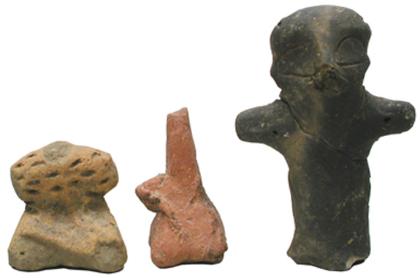Neolithic Idols

Neolithic Idols, Kiliya-type, Thessalonian, and Vinča, 6000 – 4500 BCE
Marble and terra cotta
Gift of Harlan J. and Pamela Berk, and Mr. and Mrs. Aaron R. Berk. LUMA Collection 2006-06-01-64
The LUMA collection of Neolithic Idols consists of more than 100 Kiliya-type, Thessalonian, and Vinča (modern-day Turkey, northern Greece, and Macedonia, respectively) sculptural objects and fragments.
The marble fragments of Kiliya-type sculpture are commonly called “stargazers” because the heads of the figures are tilted upward to the sky. Complete stargazer figures are extraordinarily rare, with reports of only 15 intact pieces worldwide. Kiliya idols date from as early as 4500 to 4000 BCE, and are precursors to the better-known Cycladic sculpture of ancient Greece. Due to the frequency of finding fragments rather than complete figures, the idols are thought to have been part of a ritual in which they were broken.
From the Thessalonian Neolithic period (6800–5600 BCE), the earliest objects in the collection are terra cotta with more developed facial features and indications of scarification (decorative designs incised in the clay). They are less stylized and more representational than those of Kiliya-type, but larger in scale and with prominent arms and torsos. The collection also includes Vinča idols (4500–4000 BCE) from southern Serbia. These idols were made as fertility figures or for ritualistic use, and some appear to be zoomorphic.

Neolithic Idols, Kiliya-type, Thessalonian, and Vinča, 6000 – 4500 BCE
Marble and terra cotta
Gift of Harlan J. and Pamela Berk, and Mr. and Mrs. Aaron R. Berk. LUMA Collection 2006-06-01-64
The LUMA collection of Neolithic Idols consists of more than 100 Kiliya-type, Thessalonian, and Vinča (modern-day Turkey, northern Greece, and Macedonia, respectively) sculptural objects and fragments.
The marble fragments of Kiliya-type sculpture are commonly called “stargazers” because the heads of the figures are tilted upward to the sky. Complete stargazer figures are extraordinarily rare, with reports of only 15 intact pieces worldwide. Kiliya idols date from as early as 4500 to 4000 BCE, and are precursors to the better-known Cycladic sculpture of ancient Greece. Due to the frequency of finding fragments rather than complete figures, the idols are thought to have been part of a ritual in which they were broken.
From the Thessalonian Neolithic period (6800–5600 BCE), the earliest objects in the collection are terra cotta with more developed facial features and indications of scarification (decorative designs incised in the clay). They are less stylized and more representational than those of Kiliya-type, but larger in scale and with prominent arms and torsos. The collection also includes Vinča idols (4500–4000 BCE) from southern Serbia. These idols were made as fertility figures or for ritualistic use, and some appear to be zoomorphic.
